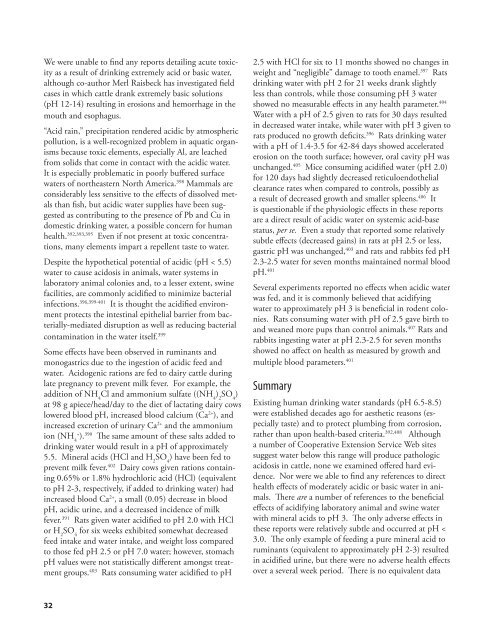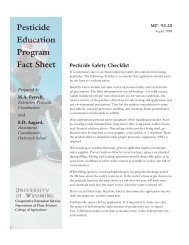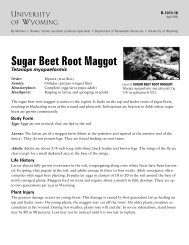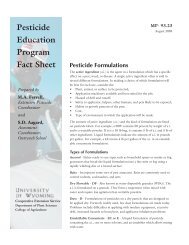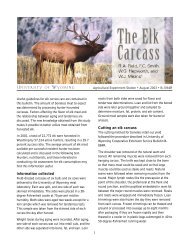Water Quality for Wyoming Livestock & Wildlife - Coming Soon!
Water Quality for Wyoming Livestock & Wildlife - Coming Soon!
Water Quality for Wyoming Livestock & Wildlife - Coming Soon!
Create successful ePaper yourself
Turn your PDF publications into a flip-book with our unique Google optimized e-Paper software.
We were unable to find any reports detailing acute toxicityas a result of drinking extremely acid or basic water,although co-author Merl Raisbeck has investigated fieldcases in which cattle drank extremely basic solutions(pH 12-14) resulting in erosions and hemorrhage in themouth and esophagus.“Acid rain,” precipitation rendered acidic by atmosphericpollution, is a well-recognized problem in aquatic organismsbecause toxic elements, especially Al, are leachedfrom solids that come in contact with the acidic water.It is especially problematic in poorly buffered surfacewaters of northeastern North America. 398 Mammals areconsiderably less sensitive to the effects of dissolved metalsthan fish, but acidic water supplies have been suggestedas contributing to the presence of Pb and Cu indomestic drinking water, a possible concern <strong>for</strong> humanhealth. 392,393,395 Even if not present at toxic concentrations,many elements impart a repellent taste to water.Despite the hypothetical potential of acidic (pH < 5.5)water to cause acidosis in animals, water systems inlaboratory animal colonies and, to a lesser extent, swinefacilities, are commonly acidified to minimize bacterialinfections. 396,399-401 It is thought the acidified environmentprotects the intestinal epithelial barrier from bacterially-mediateddisruption as well as reducing bacterialcontamination in the water itself. 399Some effects have been observed in ruminants andmonogastrics due to the ingestion of acidic feed andwater. Acidogenic rations are fed to dairy cattle duringlate pregnancy to prevent milk fever. For example, theaddition of NH 4Cl and ammonium sulfate ((NH 4) 2SO 4)at 98 g apiece/head/day to the diet of lactating dairy cowslowered blood pH, increased blood calcium (Ca 2+ ), andincreased excretion of urinary Ca 2+ and the ammoniumion (NH 4+). 390 The same amount of these salts added todrinking water would result in a pH of approximately5.5. Mineral acids (HCl and H 2SO 4) have been fed toprevent milk fever. 402 Dairy cows given rations containing0.65% or 1.8% hydrochloric acid (HCl) (equivalentto pH 2-3, respectively, if added to drinking water) hadincreased blood Ca 2+ , a small (0.05) decrease in bloodpH, acidic urine, and a decreased incidence of milkfever. 391 Rats given water acidified to pH 2.0 with HClor H 2SO 4<strong>for</strong> six weeks exhibited somewhat decreasedfeed intake and water intake, and weight loss comparedto those fed pH 2.5 or pH 7.0 water; however, stomachpH values were not statistically different amongst treatmentgroups. 403 Rats consuming water acidified to pH2.5 with HCl <strong>for</strong> six to 11 months showed no changes inweight and “negligible” damage to tooth enamel. 397 Ratsdrinking water with pH 2 <strong>for</strong> 21 weeks drank slightlyless than controls, while those consuming pH 3 watershowed no measurable effects in any health parameter. 404<strong>Water</strong> with a pH of 2.5 given to rats <strong>for</strong> 30 days resultedin decreased water intake, while water with pH 3 given torats produced no growth deficits. 396 Rats drinking waterwith a pH of 1.4-3.5 <strong>for</strong> 42-84 days showed acceleratederosion on the tooth surface; however, oral cavity pH wasunchanged. 405 Mice consuming acidified water (pH 2.0)<strong>for</strong> 120 days had slightly decreased reticuloendothelialclearance rates when compared to controls, possibly asa result of decreased growth and smaller spleens. 406 Itis questionable if the physiologic effects in these reportsare a direct result of acidic water on systemic acid-basestatus, per se. Even a study that reported some relativelysubtle effects (decreased gains) in rats at pH 2.5 or less,gastric pH was unchanged, 403 and rats and rabbits fed pH2.3-2.5 water <strong>for</strong> seven months maintained normal bloodpH. 401Several experiments reported no effects when acidic waterwas fed, and it is commonly believed that acidifyingwater to approximately pH 3 is beneficial in rodent colonies.Rats consuming water with pH of 2.5 gave birth toand weaned more pups than control animals. 407 Rats andrabbits ingesting water at pH 2.3-2.5 <strong>for</strong> seven monthsshowed no affect on health as measured by growth andmultiple blood parameters. 401SummaryExisting human drinking water standards (pH 6.5-8.5)were established decades ago <strong>for</strong> aesthetic reasons (especiallytaste) and to protect plumbing from corrosion,rather than upon health-based criteria. 392,408 Althougha number of Cooperative Extension Service Web sitessuggest water below this range will produce pathologicacidosis in cattle, none we examined offered hard evidence.Nor were we able to find any references to directhealth effects of moderately acidic or basic water in animals.There are a number of references to the beneficialeffects of acidifying laboratory animal and swine waterwith mineral acids to pH 3. The only adverse effects inthese reports were relatively subtle and occurred at pH


